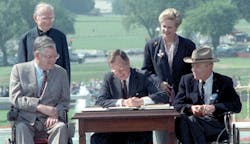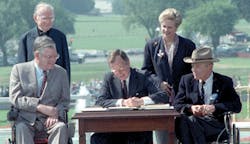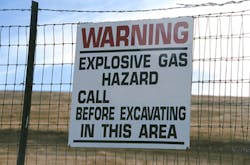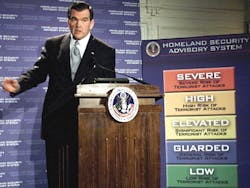100 Years of Advocacy Success: BOMA from 1907-2007
1913-1916
BOMA Intl. successfully lobbied against fuel allotments and tax increases during World War I.
1913-1916
The organization worked to establish a National Building Code and adopted both the Standardized Classification of Accounts and Standard Method of Floor Measurements. Today, BOMA Intl. is the Secretariat for the American National Standards Institute-approved office floor measurement standard (Standard Method for Measuring Floor Area in Office Buildings, ANSI/BOMA Z65.1-1996) and is working with the Houston-based Intl. Facility Management Association (IFMA) to expand the standard to address the measurement needs of industrial and retail facilities.
1933
During the Great Depression, BOMA supported the National (Industrial) Recovery Act (NRA), which was part of President Roosevelt’s New Deal. The act stimulated the U.S. economy, mandated fair wages for employees, and created jobs for the unemployed. It ultimately restored employment in the industry to its 1929 level and protected building owners and managers from operating cost increases.
1940
Testimony from BOMA’s Committee on Depreciation and Obsolescence resulted in an Oklahoma court concluding that 40 years was reasonable for the economic life of a building.
1942
BOMA President Leo Sheridan successfully proves before a Senate sub-committee that federal commercial rent control is unnecessary. In 1971, BOMA (again) successfully argued that any regulation holding rents would, in essence, be a price rollback and not a freeze. President Nixon’s emergency anti-inflation proposal was halted.
1970s
During the energy crisis, BOMA acted as an intermediary between other real estate trade groups and the U.S. Department of Energy, and Congress ultimately passed legislation that gave businesses the opportunity to create their own energy-conservation plans.
1980s
BOMA lobbied the U.S. Environmental Protection Agency (EPA) after it proposed banning the use of chlorofluorocarbons (CFCs) on the grounds that CFCs deplete the ozone layer. BOMA supported a bill that required the EPA to determine which environmental, economic, and policy factors existed before it could propose any further CFC regulations.
1984
BOMA went to war with utility associations, seeking replacement of polychlorinated biphenyl (PCB) transformers in buildings. PCBs are highly toxic, combustible, were manufactured between 1929 and 1977, and most commonly installed in apartments, commercial buildings, industrial facilities, campuses, and shopping centers built before 1978. BOMA was able to get PCB transformers removed from all buildings.
1986
Asbestos became BOMA’s top priority when, in 1986, the U.S. EPA mandated the removal of asbestos as a health hazard. BOMA President William Carleton testified several times to try to convince the EPA to conduct further studies before putting all the pressure on the real estate industry.
1990s
The landmark legislation protecting the rights of disabled persons, the Americans with Disabilities Act (ADA), was passed on July 26, 1990, and became effective Jan. 26, 1992. By working with the U.S. Department of Justice and the U.S. Access Board, BOMA successfully modified certain provisions of the ADA.
Signing of the Americans with Disabilities Act
1999
BOMA defeated legislation in the U.S. House and Senate that would have mandated forced access for telecommunications service providers (TSPs) in buildings. The organization, in partnership with the Real Access Alliance, continues to view forced building-entry privileges for TSPs as unnecessary, unmanageable, and unconstitutional.
2000s
BOMA Intl. and local BOMA associations have been instrumental in achieving adoption of the Intl. Codes (I-Codes), the only unified set of codes for the built environment. The Intl. Code Council (ICC) develops the I-Codes, which are currently in use - at the state or jurisdictional level - in 48 states.
2002
BOMA helped pass a pro-real estate brownfields bill that provides liability protection for prospective purchasers, innocent landowners, and contiguous property holders. President Bush signed the Small Business Liability Relief and Brownfields Revitalization Act on Jan. 11, 2002. The brownfields legislation amended the Comprehensive Environmental Response, Compensation, and Liability Act (CERCLA or Superfund).
Brownfields Revitalization Act was signed
2002
Following 9/11, the Terrorism Risk Insurance Act (TRIA) ensured that all businesses could purchase adequate levels of terrorism insurance coverage at reasonable rates and terms. BOMA Intl. believed so strongly in TRIA’s benefit to the real estate industry that it joined forces with the Coalition to Insure Against Terrorism (CIAT) to lobby for a renewal of the act as its 2005 expiration approached. On Dec. 16, 2005, just 2 weeks before its expiration, the Terrorism Risk Insurance Extension Act of 2005 (TRIEA) was passed.
2002
BOMA established the Real Estate Information Sharing and Analysis Center (REISAC), an information network, with the Department of Homeland Security and nine real estate associations to provide actionable security alerts directly to BOMA members.
REISAC established to provide security alerts directly to BOMA members
2004
BOMA led a successful effort to reduce leasehold depreciation rates over a 15-year schedule instead of the previous 39-year schedule. The new schedule more closely matches the reality of the marketplace.
2005
BOMA secured passage of class-action tort reform legislation that would make it easier to move class-action lawsuits from state courts to federal courts, thus eliminating the practice of plaintiffs’ attorneys filing cases in state courts known for being plaintiff friendly.
2005
BOMA was successful in incorporating tax deductions of up to $1.80 per square foot for energy-efficiency upgrades to commercial buildings into the Energy Policy Act of 2005. The Energy-Efficient Commercial Building Tax Deduction is available when qualified buildings reduce annual energy and power consumption by 50 percent compared to the ASHRAE/IESNA 90.1-2001 standard. These incentives apply to buildings or systems placed in service during 2006-2007.
Energy Policy Act, signed in 2005





